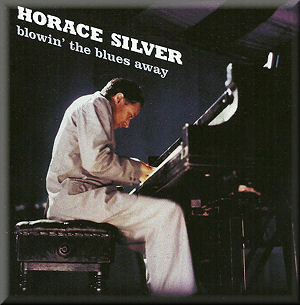1. Blowin' the Blues Away
2. The St Vitus Dance
3. Break City
4. Peace
5. Sister Sadie
6. Baghdad Blues
7. Melancholy Mood
8. How Did It Happen?
9. K. B. Blues
10. D. B. Blues
11. Nica's Dream
12. Out for Blood
Tracks 1-8
Horace Silver - Piano
Blue Mitchell - Trumpet (tracks 1, 3-6, 8)
Junior Cook - Tenor sax (tracks 1, 3-6, 8)
Gene Taylor - Bass
Louis Hayes - Drums
Track 8-12
Horace Silver - Piano
Hank Mobley - Tenor sax
Kenny Burrell - Guitar
Doug Watkins - Bass
Louis Hayes - Drums
For a while in the 1950s, Horace Silver co-led the Jazz Messengers with drummer Art Blakey. After they separated, they formed their own groups which had similar line-ups: trumpet, tenor sax and rhythm section. Blakey kept the Jazz Messengers name and both men developed styles which matched their personalities. You might say that Silver's bands were tighter, perhaps more disciplined, than Blakey's, although both of them could produce hard-swinging jazz which might be characterized as "hard bop".
This CD consists of the title LP from 1959 plus four bonus tracks from a 1957 album led by guitarist Kenny Burrell. Silver's own album was one of the finest he created and included such classic tunes as the gospelly Sister Sadie and the slower, gentler Peace, both of which became jazz standards. All but one of the LP's eight tunes were Horace's compostions, and they all make an impact.
The opening title-track is typical hard bop, with tight ensmble from trumpet and sax, followed by solos from Blue Mitchell and Junior Cook propelled by strong comping from Silver. These are followed by a melodic solo from Horace. The whole thing swings relentlessly. As Silver said "The group has a lot of fire and that's what I want". However, The St Vitus Dance shows a gentler side to Silver's playing: he reduces the group to a trio and plays in a swinging but more restrained manner. This is also true of the beautiful Peace, played by the whole quintet with delicate feeling. Blue Mitchell states the theme poetically and continues with an emotional solo, followed by an unshowy solo from Silver.
Sister Sadie is such a catchy number that it had to become popular, with its hints of gospel music and outspoken solos from Mitchell, Cook, and a bluesy middle section. Baghdad Blues is not actually a blues but it introduces an exotic, oriental mood. Melancholy Mood returns us to the trio format, with elqouently poignant piano from Silver. The two trio tracks prove that Horace was not just an exponent of funky hard bop but also a man capable of a wide range of expression. Don Newey's How Did It Happen? ends the 1959 session with a number which is boppish but not too hard.
The outstandiung track of the remaining four is Nica's Dream, another of Horace's compositions which justifiably achieved standard status. Being the group's leader, Kenny Burrell goes to town on this but he allows plenty of solo space to Hank Mobley and Horace Silver (the latter quoting the conga and Bye Bye Blackbird!). There are also two blues tunes: K. B. Blues by Kenny Burrell and D. B. Blues by Lester Young, which both swing along easily at medium tempo. The closing Out for Blood is another Burrell composition, sounding suspiciously like Strike Up the Band. Lasting more than 30 minutes, these four final tracks comprise a generous bonus, rendering one of Horace Silver's best albums even more desirable.
Tony Augarde
www.augardebooks.co.uk
